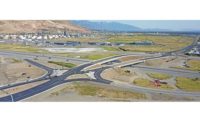ENR California's 2017 Best Projects
Highway/Bridge Best Project: I-15/I-215 Devore Interchange

The I-15/I-215 Devore interchange project transformed one of the worst grade-related bottlenecks in the country.
PHOTO COURTESY OF ATKINSON CONSTRUCTION

The I-15/I-215 Devore interchange project transformed one of the worst grade-related bottlenecks in the country.
PHOTO COURTESY OF ATKINSON CONSTRUCTION


I-15/I-215 Devore Interchange Project
San Bernardino, Calif.
Best Project and Excellence in Safety Award of Merit
Owner: California Dept. of Transportation
Design Firm/Structural/Civil/MEP Engineer: URS/AECOM
General Contractor: Atkinson Contractors LP
The I-15/I-215 Devore interchange project transformed one of the worst grade-related bottlenecks in the country. The $208-million project was finished ahead of schedule and under budget despite the challenges of rebuilding and widening highway lanes and bridges in the heavily congested corridor.
The Devore interchange was one of the most successful design-build projects of the department’s 10 pilot projects using this delivery method, says John Bulinski, District 8 director at the California Dept. of Transportation.
The efforts of general contractor Atkinson Contractors LP “helped save a year over schedule, provided additional value over the base design for no additional budget and provided a model partnership between SBCTA (San Bernardino County Transportation Authority), Caltrans and … the design-build contractor,” Bulinski says.
One of the keys to the speedy delivery of the project was the decision to revise the initial plans with the use of rapid-set concrete. By adding temporary pavement and barriers, crews could use traditional concrete pavement and precast panels for concrete replacement, which delivered a better, more durable product. Moreover, using precast concrete panels reduced the number of work crews, reducing jobsite risks.
Concerned about costs, the state had only planned route continuity for the southbound portion of I-15. The Atkinson and URS/AECOM team revised the design to include a new northbound I-15 bridge that moved traffic to the inside and thus provided route continuity.
“It seemed they gave the owner betterments without dinging them for costs,” one Best Projects judge said.
An apprenticeship program provided training to workers eager for more technical knowledge, preparing them for the next step in their careers. In addition to safety training, project leaders implemented a regular safety program. Led by foremen and crew members, the safety process took place at the start of each day and prior to starting a new activity on site. As part of the process, all crew members had to identify hazards for each upcoming jobsite activity.
Related Article: Communities Are the Real Winners





